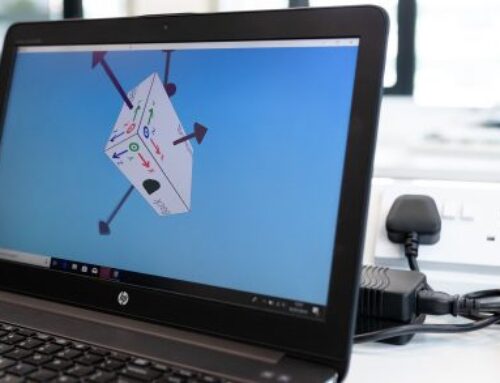Was Sie über das Augmented-Reality Toolkit DAQRI wissen sollten.
DAQRI, ein führender AR-Innovator (Augmented Reality), hat kürzlich sein smartes Helmet mit der Bezeichnung „die weltweit erste tragbare Mensch-Maschine-Schnittstelle“ veröffentlicht.
In dem folgenden Beitrag präsentieren wir ihnen ein Interview mit dem Vize-Präsidenten von DAQRI, Matt Kammerait, über den Helm, die Strategie des Unternehmens und die Zukunft von AR und ähnlicher verwandter Bereiche wie Robotik.
Das englische Orginal-Interview finden Sie auf der folgenden Website.

Smart Helmet – Was ist so besonders?
Der Helm wurde entwickelt, um in eine Vielzahl von industriellen Umgebungen zu passen, in denen die Arbeiter mit Maschinen und einer oft schwierigen Umgebung interagieren müssen. Es hat eine Helmaußenseite, einen Gesichtsschutz, eine Reihe von Kameras, einschließlich Infrarot und HD, vier Mikrofone und ein Sensorpaket, das eine 360 Grad-Erkennung der Umgebung um den Arbeiter herum ermöglicht.
Der Helm ermöglicht es dem Arbeiter, die aktuelle Szene vor ihm zu sehen, während die AR auch Informationen über die Elemente anzeigt, die dieser gerade betrachtet. Sie können je nach Bedarf kommunizieren und relevante Informationen oder Unterstützung abrufen.
Kammerait beschreibt den Helm als „ausgewogen, sehr geschützt und so konzipiert, dass er sich in das bestehende Ökosystem des Benutzers einfügt“. Dies ist von entscheidender Bedeutung, da der Helmet-Träger in typischen Anwendungsfällen Informationen aus dem bestehenden System des Unternehmens oder der Einrichtung bezieht und neue Eingaben macht.
Ziel war es, den Helm auch unter extremen Bedingungen einsatzbereit und sicher zu machen sowie die Bedienung so freihändig wie möglich zu gestalten.
Inside Smart Helmet: das Innere und Apps.
Der Helm verwendet ein Intel RealSense Kamerapaket, von dem Intel behauptet, dass es „wie das menschliche Auge sehen“ kann, um Tiefe zu erfassen und menschliche Bewegungen zu verfolgen“. Es beinhaltet auch Intels Sixth Gen Core M7 Prozessor. Das von DAQRI entwickelte Intellitrack-Programm ermöglicht eine visuelle Trägheitsnavigation.
Die ersten Anwendungen für den Helm beinhalten:
- Erweiterte Schritt-für-Schritt Anleitungen,
- thermische Sicht, die Temperaturprobleme in Geräten oder Umgebungen erkennen kann,
- Datenvisualisierung – die einem Mitarbeiter Datenanzeigen eines in einem Kontrollraum verfügbaren Typs lifern.
- Verbindung zu Remote-Experten.
Das Unternehmen stellt Fallstudien zu jeder dieser Fähigkeiten zur Verfügung, die in realen Industriekundenbaustellen eingesetzt werden.
Da der Helm im typischen Fall in der Lage sein muss, mit dem bestehenden Informationsökosystem des Kunden zu kommunizieren, kann dies oft eine gewisse Anpassung der Software oder Intergration erfordern. Kammerait sagte dazu, dass das Unternehmen nicht plant, Anpassungen als Service anzubieten, sondern eng mit Systemintegratoren wie Accenture oder IBM zusammenarbeiten wird, die den Service anbieten können.
Konnektivitätsfähigkeiten.
Was die Konnektivität betrifft, so verfügt der Helm über WiFi-,Bluetooth und Mobilfunkfähigkeiten. Er stellt jedoch fest, dass der Mobilfunkgebrauch noch nicht zertifiziert ist. Die genauen Verbindungsmethoden werden typischerweise durch die Vorschriften der Branche bestimmt, in der sich der Kunde befindet.
Es gibt Situationen, in denen der Helm in einem Modus betrieben werden kann, der nicht mit den Ökosystem des Kunden verbunden ist. Ein Beispiel könnte sein, wenn eine Gruppe in eine Hochsicherheitseinrichtung gebracht wird. In diesem Fall werden die Daten auf dem Gerät gesammelt und später übertragen.
Wenn er angeschlossen ist, kann sich der Helm mit dem bestehenden Ökosystem verständigen. Es kann das Sammeln und Übermitteln neuer Daten oder das Empfangen bestehender Daten sein. Der Helm wird mit informationen über die akzeptierten Messwerte ausgestattet und kann anomale Daten erkennen und Warnmeldungen für mögliche Notfälle senden.
Während der Helm so konzipiert ist, dass er dem Träger die Freisprechfunktion so weit wie möglich ermöglicht, wies Kammerait darauf hin, dass es in einigen Situationen notwendig ist, ein Sekundärgerät zu verwenden. Derzeit können sie die Nutzung von Smartphones, aber nicht von Tablets aufnehmen. In diesen Fällen wird die Sekundärvorrichtung für die Touch-Control-Signalisierung verwendet.
Das System ermöglicht auch Sprachbefehle und die Verfolgung von Blickwinkeln. Wenn Sie z.B. für eine bestimmte Anzahl von Sekunden nach links schauen, werden Informationen über den Artikel angezeigt, den Sie gerade betrachten.
Es wurde viel Wert darauf gelegt, die Latenzzeit der Informationsübertragung in allen Funktionen des Helmes zu reduzieren. Kammerait sagt, dass sie es auf einen Frame beschränken und versuchen werden, einen Schwellenwert von 10 Millisekunden zu erreichen.
DAQRIs Weg bis zum Smart Helmet.
Die DAQRI hat eine interessante Reise zu ihrem jetztigen Status hinter sich. Ursprünglich war das Unternehmen ein Anbieter von AR-Software, die es an Unternehmen wie Microsoft und Facebook für Wearables-Anwendungen verkaufen wollte.
Kammerait erklärt, dass Hardware wie Google Glass und andere AR-Geräte im Frühstadium nicht für den harten industriellen Einsatz geeignet sind. DAQRI begann von vorne, „mit einem leeren Blatt, wo das Unternehmen nicht nach Möglichkeiten suchte, Add-on-Fähigkeiten für Endgeräte zu erreichen“.
Sie beschlossen, sich auf Industrieunternehmen zu konzentrieren. „Wir glauben, dass wir einzigartig sind, denn auch die anderen Anbieter auf dem Industriemarkt sind teilweise an Verbraucherlösungen beteiligt, wir nicht.“ Er erlaubt, dass der Konsumbereich für das Unternehmen irgendwann in der Zukunft „wieder Sinn machen könnte“.
Während der Zeit, in der DAQRI auf den Helm hinarbeitete, verzeichnete er ein beeindruckendes Wachstum, von 30 Mitarbeitern in den Jahren 2013-14 auf heute über 300. Das Geschäft des Unternehmens in der Zwischenzeit wurde zum Teil auch Pilotprogrammen mit führenden Industrieunternehmen zu den Themen Mensch-Maschine-Schnittstelle sowie einer weiteren Produktlinie, dem 4D Studio von DAQRI, abgeleitet. 4D Studio bietet eine Autorenumgebung für IoT-bezogene Software, z.B. Arbeitsanweisungen. Die Umsätze enthielten auch einen erheblichen Anteil an den Dienstleistungen, wie z.B. die Schulung der Anwender in der Anwendung von AR.
Holographie & Automotive AR – Two Trees Akquisition.
Im März 2016 übernahm DAQRI Two Trees Photonics, einen Anbieter von dynamischer holographischer Technologie. Nach einer langen Entwicklungszeit begann Two Trees mit der Lieferung von Technologie für die Automobilindustrie für eine Head-up-Darstellung von Informationen über die Windschutzscheiben der Fahrer, wobei Jaguar Land Rover der erste Kunde war.
Neben den Möglichkeiten, die Holographie in die Industrieprodukte von DAQRI zu integrieren, zeigt sich Kammerait sehr begeistert von den Möglichkeiten im Automobilbereich. „Wir waren zunächst etwas skeptisch gegenüber dem Markt, aber das änderte sich nach Gesprächen mit Automobilpartnerunternehmen.“ Er sieht eine große Rolle für AR in Fahrzeugen, für Apps wie die Bereitstellung von Hinweisen für Fahrer und den 360-fachen Informationszugang.
DAQRI Wachstumspläne und Strategie.
Da das Unternehmen erst am Anfang des Verkaufszyklus des Helmes steht, ist die erste Strategie, den Umsatz mit diesem Produkt zu steigern. Kammerait erklärt, dass sie sich auf Kunden konzentrieren, die erhebliche Ausgaben in den Bereichen Anlagenüberwachung und Inspektion haben. In diesen Fällen ersetzen sie wahrscheinlich den Kauf von Tablets oder anderen Computern. Er glaubt, dass sie Verkäufe in den Hunderttausenden von Einheiten der ersten Helmet-Produktkonfiguration erreichen können.
Er erklärt, dass es sich hierbei um eine High-End-Fähigkeit handelt und sie können Varianten auch zu niedrigeren Preisen anbieten. Auf jeden Fall stellt er fest, dass sie bereits eine starke Nachfrage verzeichnen und das Angebot am Helmen eingeschränkt ist. (CNET spekulierte, dass der Helm für $5.000 – $15.000 pro Einheit verkauft wird. „Kopf an mit einem intelligenten Helm, der nach einem köstlichen Getränk benannt ist“.
Er ist auch optimistisch, was ihr Potenzial im Automobilbereich angeht. Er sagt: „Es wird groß sein, wie der Helm“.
Zusätzlich zur jüngsten Übernahme von Two Trees tätigte das Unternehmen im Jahr 2015 weitere Akquisitionen, die seine Produktpalette erweiterten. Dazu gehörte Melon, das ein EEG-Tracking-Stirnband anbietet, das elektrische Aktivität des Gehirns erkennt, die nach Angaben des Unternehmens sowohl innerhalb des Smart Helmet als auch für mögliche Anwendungen im Gesundheitswesen Anwendung finden würde.
Sie erwarben auch ARToolworks, das die ARToolKit-Bibliotheken produzierte. DAQRI äußerste sich zu ARToolKit offiziell folgendermaßen: „ARToolKit ist ein plattformübergreifendes Software Developer Kit (SDK), mit dem Entwickler AR-Anwendungen für alle wichtigen Plattformen – Linux, Mac, PC, Android und iOS – erstellen können“.
Robotik & AR – die Zukunft.
Wir haben Kammerait nach der Tatsache gefragt, dass Robotergeräte in vielen der Umgebungen arbeiten, die der Helm anstrebt, und nach seinem Blick auf die Zukunft. Er erklärte, dass er sieht, dass sich die Fähigkeiten von Mensch zu Maschine im industriellen Umfeld Seite an Seite verbessern.
„Wir werden sehen, dass beide optimiert werden“, sagte er, „aber es gibt Situationen mit Problemlösung und kritischem Denken mit vielen Inputs, in denen menschliches Engagement erforderlich ist. Für repetitivere Aufgaben können Maschinen besser sein. Aber ein Mensch muss die Maschine an kritischen Punkten führen.“
Er bemerkte auch, dass DAQRI an der „blutigen Kante der Sensorik“ arbeitet. Er sagt, dass sie sich mit Entwicklungen aus einer Reihe von Bereichen befassen, darunter KI, organische und neuronale Netze. Er stellte fest, dass es einen Zusammenfluss von Entwicklungen sowohl im Software- als auch im physikalischen Bereich gibt. Er weist darauf hin, dass „Mit IoT benötigen Sie eine Übersetzungsschicht, damit der Mensch den Informationsfluss nutzen kann“.
AR entwickelt sich immer mehr vom Netten zum Wichtigen.
Wir erinnern uns an die Tage, als das Beispiel einer AR-App so etwas wie das Folgende war: „Sie stehen auf einer Piazza in Bologna und richten ihr Smartphone auf ein Restaurant und es erscheinen auf dem Bildschirm Informationen über die Speisekarte, die Öffnungszeiten etc.“.
Schön, mit anderen Worten, aber kaum vielversprechende signifikante Bewertungseffekte in der realen Welt zu haben.
Im Gegensatz dazu ist der Smart Helmet eine Entwicklung, die eine potenzielle echte Wertschöpfung verspricht.
Neben dieser hochinteressanten Entwicklung sind wie sehr fasziniert vom ständigen Zusammenspiel von Maschinen, d.h. Robotern und Menschen am Arbeitsplatz. Wir halten die Kommentare von Kammerait zu den nützlichen komplementären Beziehungen für würdig, in zukünftigen Beiträgen etwas näher darauf einzugehen.
Vielen Dank für ihren Besuch


